Firefighters need to be aware of the importance of fundamental search methods and the limitations of thermal imaging cameras. There are several TIC manufacturers that falsely advertise that their brand of TIC will “see” through steam. This is inherently dangerous and a false statement for them to spread because in many cases the TIC will not be able to see through dense steam, cold smoke situations (created by sprinklers), or high moisture content environments.
Why can’t a TIC see through steam/moisture?
First of all, TIC’s don’t “see” through anything. A fire service TIC detects long wave infrared radiation (LWIR) which is between 7-14 microns. These LWIR are able to pass through smoke with relative ease and be detected by our type of thermal imaging cameras. However, there are many variables that will prevent a TIC from “seeing” or providing visibility. Firefighters need to be aware that the TIC should NEVER be used as their sole source of orientation. They should conduct a detailed size-up prior to making entry to provide a mental map of the area in question that will be searched (preplanning and knowing our first due response area is critical in this area). However, a high resolution TIC can help a firefighter prevent disorientation. As shown in the photo below, we can see the hose line shows up dark as the water within it is colder than the environment around it. This allows a disoriented firefighter to quickly rejoin their crew or find their way out if needed.
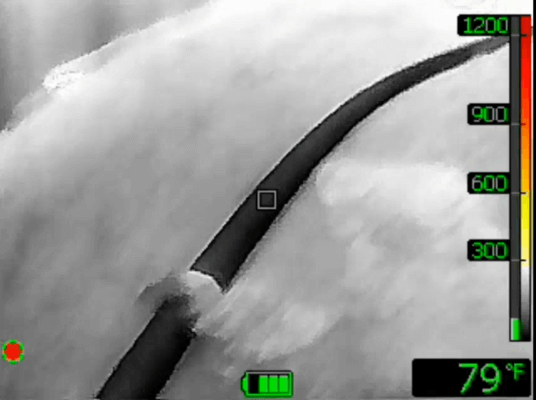
Upon making entry into a structure, a means of orientation other than the TIC should be employed as the foundation such as:
• A charged hose-line
• A search-rope
• An oriented Firefighter who stays at the wall/doorways
These areas are NON- NEGOTIABLES as firefighters can become easily disoriented without a point of reference in the zero visibility conditions that we often face.
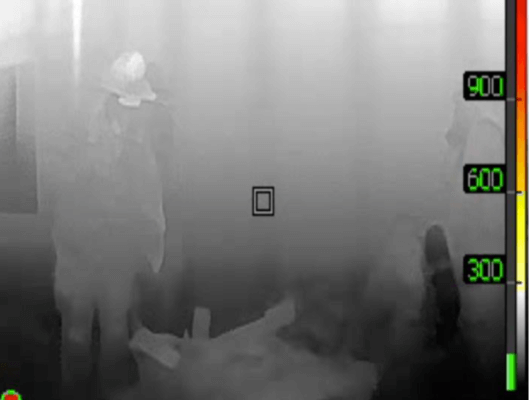
In regard to steam/moisture laden environments, thermal imaging can be rendered ineffective due to several factors:
TIC’s work off the principle of emissivity. Any object that is viewed is compared to a perfect black body with an emissivity of 1. Fire Service TIC’s are set at .95 to .97 emissivity which is the common emissivity of everyday combustibles (carbonaceous materials-human skin, soot, wood, and in general most rough services). Any object or area that is viewed that is closer to zero emissivity is considered a mirror. These objects reflect infrared energy and provide either false readings and do not allow infrared energy to pass through.
What is the emissivity of water?
Water typically has an emissivity of .95-.96 which would lead us to believe that we could accurately measure the temperature of the surface and we can! This can be demonstrated by pointing the TIC at the surface of a cup of ice water. However, the TIC will read the surface temperature of the water but cannot “see through” the water as it doesn’t see through walls or other materials. The TIC reads temperature differences on surfaces and can detect convection currents.
Why does steam block our ability to see with the TIC if the emissivity is close to what our TIC is set at?
There are several reasons why cold smoke and moisture laden environments block our ability to see with the TIC. First, a fire service TIC has an optic system that consists of a germanium lens (found at the front of the TIC). Germanium is a thin metal that has high transmissivity properties that allows Infrared energy to pass through it, so the detector can then translate the IR signal into an image that we as firefighters later interpret. The issue occurs in any environment, whether heavy smoke or heavy moisture, when the particulate or moisture builds up on the germanium lens. This blocks the TIC’s ability to “see”.
In our courses at Insight Training, we teach firefighters each time they wipe their Face piece that they should also wipe the lens of the TIC to prevent blocking the optic lens. As the amount of moisture or smoke increases, so should the frequency of the number of times the lens must be wiped.
There are numerous incidents of Fire Service TIC’s ‘whiting out’ after firefighters opened their nozzle or entered cold smoke/sprinkler discharged environments. In most of these cases, the lens has failed to be cleared/wiped regularly leaving moisture on the lens. The TIC cannot see through the moisture and produces a white image as it is reading the moisture and not the IR energy that should be passing through to the detector.
What happens when I wipe the lens and I still can’t see? Why is this occurring?
In certain environments a TIC can be rendered blind due to the following: Low uniform temperatures (the entire area within the field of view is the same temperature such as the adjacent photo). The firefighters almost blend in with the background due to their gear being heated to close to the temperature of the environment.
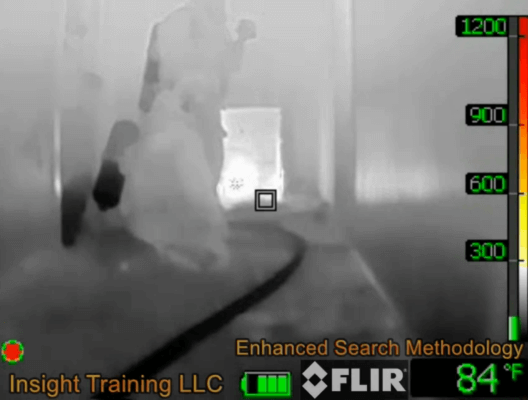
High moisture content environments: (such as multiple sprinkler heads flowing in a cold smoke environment).
As you can see (in the photo below) before the stream reaches the target space, visibility through the TIC is relatively clear.
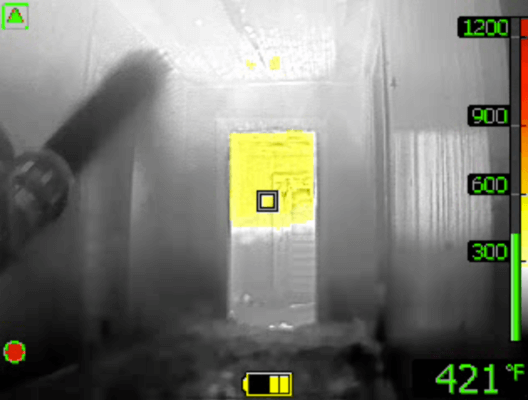
Notice, in the second photo how the steam and moisture obscure the TIC’s ability to discern details within the field of view. Even though, we have dramatically reduced the temperatures inside the structure; our visibility is momentarily obscured. With a sprinkler system actively flowing, this will exacerbate the problem in reducing our visibility.
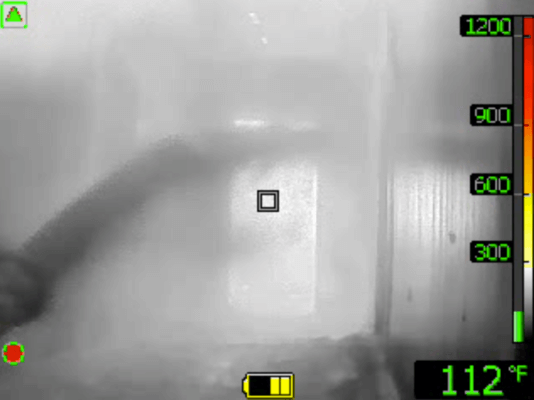
High uniform temperatures (All TIC’s have a maximum dynamic range or temperature range and if the area within the field of view has reached this a firefighter will see no discernible details as the TIC has reached saturation. Most TIC’s reach this at 1200 degrees Fahrenheit. This is known as saturation which was formerly known as white out.
• How can we overcome these limitations?
Steam blocking the lens in low moisture content environments can be overcome by wiping the lens and keeping the TIC out of the discharge (either sprinkler head or nozzle spray). Also, the crew leader needs to keep the TIC in the best position for field of view. In other words, we should not expect to raise the TIC up in the spray of the mist from a sprinkler head and be able to clearly see. It will distort or block our view. A trained crew leader “looks both ways before we cross the street” checking and familiarizing themselves with the area before they are in an environment that will prevent TIC use.
Low Resolution TIC’s will also be problematic in these environments: Any TIC with a 160×120 resolution has an effective search range of 7 feet. If we add uniform temperatures and moisture laden environments these TIC’s are rendered useless due to their low resolution and high thermal sensitivity such as the example below comparing a low-resolution TIC vs. a high- resolution TIC. The firefighter is invisible in the low-resolution TIC but is visible in the high- resolution TIC.
Know your TIC, Know it’s limitation, and stay Intelligently Aggressive!
